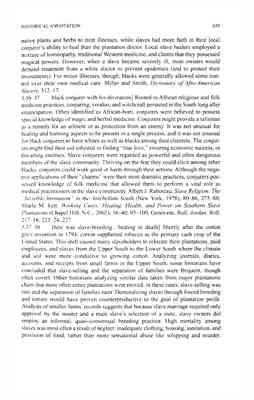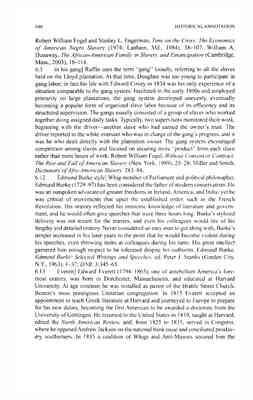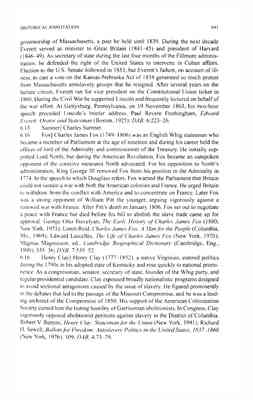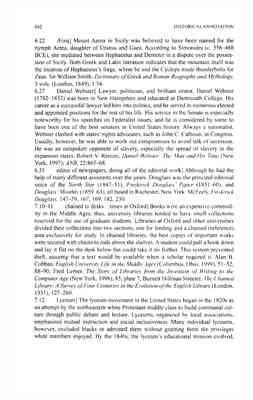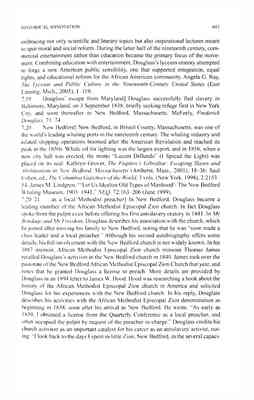Pages
11
HISTORICAL ANNOTATION 639
native plants and herbs to treat illnesses, while slaves had more faith in their local conjuror's ability to heal than the plantation doctor. Local slave healers employed a mixture of homeopathy, traditional Western medicine, and claims that they possessed magical powers. However, when a slave became severely ill, most owners would demand treatment from a white doctor to prevent epidemics (and to protect their investments). For minor illnesses, though, blacks were generally allowed some control over their own medical care. Miller and Smith, Dictionary of Afro-American Slavery, 312-17 . 5.36-37 black conjurer with his divination] Rooted in African religious and folk medicine practices, conjuring, voodoo, and witchcraft persisted in the South long after emancipation. Often identified as African-born, conjurers were believed to possess special knowledge of magic and herbal medicine. Conjurers might provide a talisman as a remedy for an ailment or as protection from an enemy. It was not unusual for healing and harming aspects to be present in a single process, and it was not unusual for black conjurers to have whites as well as blacks among their clientele. The conjurers might find their aid solicited in finding "true love," ensuring economic success, or thwarting enemies. Slave conjurers were regarded as powerful and often dangerous members of the slave community. Thriving on the fear they could elicit among other blacks, conjurers could work good or harm through their actions. Although the negative applications of their "charms" were their most dramatic practices, conjurers possessed knowledge of folk medicine that allowed them to perform a vital role as medical practitioners in the slave community. Albert J. Raboteau, Slave Religion: The "Invisible Institution" in the Antebellum South (New York, 1978), 80-86, 275-88; Sharla M. Fett, Working Cures: Healing, Health, and Power on Southern Slave Plantations (Chapel Hill, N.C., 2002), 38-40, 95-100; Genovese, Roll, Jordan, Roll, 217-18, 223-24, 227. 5.37-38 Here was slave-breeding...beating to death] Shortly after the cotton gin's invention in 1794, cotton supplanted tobacco as the primary cash crop of the United States. This shift caused many slaveholders to relocate their plantations, paid employees, and slaves from the Upper South to the Lower South where the climate and soil were more conducive to growing cotton. Analyzing journals, diaries, accounts, and receipts from small farms in the Upper South, some historians have concluded that slave-selling and the separation of families were frequent, though often covert. Other historians analyzing similar data taken from major plantations claim that more often entire plantations were moved; in these cases, slave-selling was rare and the separation of families rarer. Demoralizing slaves through forced breeding and torture would have proven counterproductive to the goal of plantation profit. Analysis of smaller farms' records suggests that because slave marriage required only approval by the master and a male slave's selection of a mate, slave owners did employ an informal, quasi-consensual breeding practice. High mortality among slaves was most often a result of neglect; inadequate clothing, housing, sanitation, and provision of food, rather than more sensational abuse like whipping and murder.
12
640 HISTORICAL ANNOTATION
Robert William Fogel and Stanley L. Engerman, Time on the Cross: The Economics of American Negro Slavery (1974; Lanham, Md., 1984), 38-107; William A. Dunaway, The African-American Family in Slavery and Emancipation (Cambridge, Mass., 2003), 18-114. 6.3 in his gang] Ruffin uses the term "gang" loosely, referring to all the slaves held on the Lloyd plantation. At that time, Douglass was too young to participate in gang labor; in fact his life with Edward Covey in 1834 was his only experience of a situation comparable to the gang system. Instituted in the early 1800s and employed primarily on large plantations, the gang system developed unevenly, eventually becoming a popular form of organized slave labor because of its efficiency and its structured supervision. The gangs usually consisted of a group of slaves who worked together doing assigned daily tasks. Typically, two supervisors monitored their work, beginning with the driver--another slave who had earned the owner's trust. The driver reported to the white overseer who was in charge of the gang's progress, and it was he who dealt directly with the plantation owner. The gang system encouraged competition among slaves and focused on securing more "product" from each slave rather than more hours of work. Robert William Fogel, Without Consent or Contract: The Rise and Fall of American Slavery (New York, 1989), 25-28; Miller and Smith, Dictionary of Afro-American Slavery, 283-84. 6.12 Edmund Burke style] Whig member of Parliament and political philosopher, Edmund Burke (1729-97) has been considered the father of modem conservatism. He was an outspoken advocate of greater freedoms in Ireland, America, and India, yet he was critical of movements that upset the established order, such as the French Revolution. His oratory reflected his immense knowledge of literature and government, and he would often give speeches that were three hours long. Burke's stylized delivery was not meant for the masses, and even his colleagues would tire of his lengthy and detailed oratory. Never considered an easy man to get along with, Burke's temper increased in his later years to the point that he would become violent during his speeches, even throwing items at colleagues during his rants. His great intellect garnered him enough respect to be tolerated despite his outbursts. Edmund Burke, Edmund Burke: Selected Writings and Speeches, ed. Peter J. Stanlis (Garden City, N.Y., 1963), 1-37; DNB, 3:345-65. 6.13 Everett] Edward Everett (1794-1865), one of antebellum America's foremost orators, was born in Dorchester, Massachusetts, and educated at Harvard University. At age nineteen he was installed as pastor of the Brattle Street Church, Boston's most prestigious Unitarian congregation. In 1815 Everett accepted an appointment to teach Greek literature at Harvard and journeyed to Europe to prepare for his new duties, becoming the first American to be awarded a doctorate from the University of Goettingen. He returned to the United States in 1819, taught at Harvard, edited the North American Review, and, from 1825 to 1835, served in Congress, where he opposed Andrew Jackson on the national bank issue and conciliated proslavery southerners. In 1835 a coalition of Whigs and Anti-Masons secured him the
13
HISTORIC AL ANNOTATION 641
governorship of Massachusetts, a post he held until 1839. During the next decade Everett served as minister to Great Britain (1841-45) and president of Harvard (1846-49). As secretary of state during the last four months of the Fillmore administration, he defended the right of the United States to intervene in Cuban affairs. Election to the U.S. Senate followed in 1853, but Everett's failure, on account of illness, to cast a vote on the Kansas-Nebraska Act of 1854 generated so much protest from Massachusetts antislavery groups that he resigned. After several years on the lecture circuit, Everett ran for vice president on the Constitutional Union ticket in 1860. During the Civil War he supported Lincoln and frequently lectured on behalf of the war effort. At Gettysburg, Pennsylvania, on 19 November 1863, his two-hour speech preceded Lincoln's briefer address. Paul Revere Frothingham, Edward Everett: Orator and Statesman (Boston, 1925); DAB, 6:223-26. 6.13 Sumner] Charles Sumner. 6.16 Fox] Charles James Fox (1749-1806) was an English Whig statesman who became a member of Parliament at the age of nineteen and during his career held the offices of lord of the Admiralty and commissioner of the Treasury. He initially supported Lord North, but during the American Revolution, Fox became an outspoken opponent of the coercive measures North advocated. For his opposition to North's administration, King George III removed Fox from his position in the Admiralty in 1774. In the speech to which Douglass refers, Fox warned the Parliament that Britain could not sustain a war with both the American colonies and France. He urged Britain to withdraw from the conflict with America and to concentrate on France. Later Fox was a strong opponent of William Pitt the younger, arguing vigorously against a renewed war with France. After Pitt's death in January 1806, Fox set out to negotiate a peace with France but died before his bill to abolish the slave trade came up for approval. George Otto Trevelyan, The Early History of Charles James Fox (1880; New York, 1971); Loren Reid, Charles James Fox: A Man for the People (Columbia, Mo., 1969); Edward Lascelles, The Life of Charles James Fox (New York, 1970); Magnus Magnusson, ed., Cambridge Biographical Dictionary (Cambridge, Eng., 1990), 535-36; DNB, 7:535-52. 6.16 Henry Clay] Henry Clay (1777-1852), a native Virginian, entered politics during the 1790s in his adopted state of Kentucky and rose quickly to national prominence. As a congressman, senator, secretary of state, founder of the Whig party, and regular presidential candidate, Clay espoused broadly nationalistic programs designed to avoid sectional antagonism caused by the issue of slavery. He figured prominently in the debates that led to the passage of the Missouri Compromise, and he was a leading architect of the Compromise of 1850. His support of the American Colonization Society earned him the lasting hostility of Garrisonian abolitionists. In Congress, Clay vigorously opposed abolitionist petitions against slavery in the District of Columbia. Robert V. Remini, Henry Clay: Statesman for the Union (New York, 1991); Richard H. Sewell, Ballots for Freedom: Antislavery Politics in the United States, 1837-1860 (New York, 1976), 109; DAB, 4:73-79.
14
642 HISTORICAL ANNOTATION
6.22 AEtna] Mount Aetna in Sicily was believed to have been named for the nymph Aetna, daughter of Uranus and Gaea. According to Simonides (c. 556-468 BCE), she mediated between Hephaestus and Demeter in a dispute over the possession of Sicily. Both Greek and Latin literature indicates that the mountain itself was the location of Hephaestus's forge, where he and the Cyclops made thunderbolts for Zeus. Sir William Smith, Dictionary of Greek and Roman Biography and Mythology, 3 vols. (London, 1849), I:54. 6.27 Daniel Webster] Lawyer, politician, and brilliant orator, Daniel Webster (1782-1852) was born in New Hampshire and educated at Dartmouth College. His career as a successful lawyer led him into politics, and he served in numerous elected and appointed positions for the rest of his life. His service in the Senate is especially noteworthy for his speeches on Federalist issues, and he is considered by some to have been one of the best senators in United States history. Always a nationalist, Webster clashed with states' rights advocates, such as John C. Calhoun, in Congress. Usually, however, he was able to work out compromises to avoid talk of secession. He was an outspoken opponent of slavery, especially the spread of slavery in the expansion states. Robert Y. Remini, Daniel Webster: The Man and His Time (New York, 1997); ANB, 22:865-68. 6.35 editor of newspapers, doing all of the editorial work] Although he had the help of many different assistants over the years, Douglass was the principal editorial voice of the North Star (1847-51), Frederick Douglass' Paper (1851-60), and Douglass' Monthly (1859-63), all based in Rochester, New York. McFeely, Frederick Douglass, 147-59, 167, 169, 182, 230. 7.10-11 chained to desks. . .times at Oxford] Books were an expensive commodity in the Middle Ages; thus, university libraries tended to have small collections reserved for the use of graduate students. Libraries at Oxford and other universities divided their collections into two sections, one for lending and a chained (reference) area exclusively for study. In chained libraries, the best copies of important works were secured with chains to rods above the shelves. A student could pull a book down and lay it flat on the desk below but could take it no further. This system prevented theft, assuring that a text would be available when a scholar required it. Alan B. Cobban, English University Life in the Middle Ages (Columbus, Ohio, 1999), 51-52, 88-90; Fred Lerner, The Story of Libraries from the Invention of Writing to the Computer Age (New York, 1998), 85, plate 7; Burnett Hillman Streeter, The Chained Library: A Survey of Four Centuries in the Evolution of the English Library (London, 1931), 127-260. 7.12 Lyceum] The lyceum movement in the United States began in the 1820s as an attempt by the northeastern white Protestant middle class to build communal culture through public debate and lecture. Lyceums, organized by local associations, emphasized mutual instruction and social inclusiveness. Many individual lyceums, however, excluded blacks or admitted them without granting them the privileges white members enjoyed. By the 1840s, the lyceum's educational mission evolved,
15
HISTORICAL ANNOTATION 643
embracing not only scientific and literary topics but also inspirational lectures meant to spur moral and social reform. During the latter half of the nineteenth century, commercial entertainment rather than education became the primary focus of the movement. Combining education with entertainment, Douglass 's lyceum oratory attempted to forge a new American public sensibility, one that supported integration, equal rights, and educational reform for the African American community. Angela G . Ray, The Lyceum and Public Culture in the Nineteenth-Century United States (East Lansing, Mich., 2005), 1-119. 7.19 Douglass' escape from Maryland] Douglass successfully fled slavery in Baltimore, Maryland, on 3 September 1838, briefly seeking refuge first in New York City, and soon thereafter in New Bedford, Massachusetts. McFeely, Frederick Douglass, 71-74. 7.20 New Bedford] New Bedford, in Bristol County, Massachusetts, was one of the world's leading whaling ports in the nineteenth century. The whaling industry and related shipping operations boomed after the American Revolution and reached its peak in the 1850s. Whale oil for lighting was the largest export, and in 1856, when a new city hall was erected, the motto "Lucem Diffundo" (I Spread the Light) was placed on its seal. Kathryn Grover, The Fugitive's Gibraltar: Escaping Slaves and Abolitionism in New Bedford, Massachusetts (Amherst, Mass., 2001), 18-36; Saul Cohen, ed., The Columbia Gazeteer of the World, 3 vols. (New York, 1998), 2:215354; James M. Lindgren, "'Let Us Idealize Old Types of Manhood': The New Bedford Whaling Museum, 1903-1941," NEQ, 72:163-206 (June 1999). 7.20 21 as a local Methodist preacher] In New Bedford. Douglass became a leading member of the African Methodist Episcopal Zion church. In fact Douglass spoke from the pulpit even before offering his first antislavery oratory in 1841. In My Bondage and My Freedom, Douglass describes his association with the church, which he joined after moving his family to New Bedford, noting that he was "soon made a class leader and a local preacher." Although his second autobiography offers some details, his full involvement with the New Bedford church is not widely known. In his 1887 memoir, African Methodist Episcopal Zion church minister Thomas James recalled Douglass's activism in the New Bedford church in 1840. James took over the pastorate of the New Bedford African Methodist Episcopal Zion Church that year, and notes that he granted Douglass a license to preach. More details are provided by Douglass in an 1894 letter to James W. Hood. Hood was researching a book about the history of the African Methodist Episcopal Zion church in America and solicited Douglass for his experiences with the New Bedford church. In his reply, Douglass describes his activities with the African Methodist Episcopal Zion denomination as beginning in 1838, soon alter his arrival in New Bedford. He wrote, "As early as 1839, I obtained a license from the Quarterly Conference as a local preacher, and often occupied the pulpit by request of the preacher in charge." Douglass credits his church activism as an important catalyst for his career as an antislavery activist, noting: "I look back to the days I spent in little Zion, New Bedford, in the several capacities
